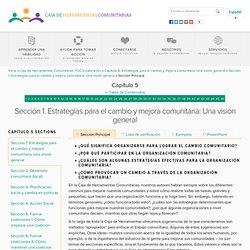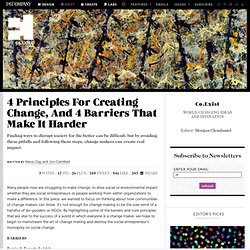

A Guide to Defending Democracy. Training For Change. This Board Game Is Designed For Activists To Practice Building Movements. After living in a converted dumpster for the better part of a year in 2015, Jeff Wilson had an epiphany about tiny-house living: In order to create a small space that could convince people to move out of oversized homes, it might make sense to work with a product designer, not just architects.

Wilson, who was known as Professor Dumpster at the time, was an environmental sciences professor at Huston-Tillotson University in Austin who embarked on the dumpster experiment as a commentary on the sustainability benefits of living small. He left academia to launch Kasita, a startup that now has a design for a sleek, very un-dumpster-like tiny home. The design was led by a product designer. "When you live in a 33-square-foot dumpster, you don't get to have unusable space," Wilson tells Co.Exist. "Product designers think completely differently about how you interact with a space.
The human-centered design makes the tiny size livable. [Photos: Kasita] Consciencia Colectiva para la Acción. www.provecino.org.mx/pdfs/M_Organizacion_Vecinal.pdf. www.rebelion.org/docs/97084.pdf. Sección Principal. ¿Qué significa organizarse para lograr el cambio comunitario?

¿Por qué participar en la organización comunitaria? ¿Cuáles son algunas estrategias efectivas para la organización comunitaria? ¿Cómo provocar un cambio a través de la organización comunitaria? En la Caja de Herramientas Comunitarias, nuestros autores hablan siempre sobre los diferentes caminos para mejorar nuestras comunidades y sobre cómo realizar todas las tareas, grandes y pequeñas, que hacen que una organización funcione y lo haga bien. Sin embargo, hablando en términos generales, ¿cómo funciona todo esto? A lo largo de toda la Caja de Herramientas ofrecemos sugerencias de lo que consideramos son métodos “apropiados” para enfocar el trabajo comunitario. Una de estas ideas es la organización comunitaria – la noción de que la gente puede y debe reunirse para hablar sobre lo que es importante, y después trabajar juntos para obtener el cambio en sus comunidades.
Revolution: An Instruction Manual. 10 Points On The Science Of Spreading The Word. This piece is from a new PopTech Edition about harnessing social contagion for social good.

Visit for more interviews, essays and videos with leading thinkers on this subject. 1. Good deeds are contagious We naturally imitate the people around us, we adopt their ideas about appropriate behavior, and we feel what they feel. Acts of charity are no exception. 2. That same experiment showed that contagious generosity spreads up to three steps through the network (from person to person to person to person), and when we added up all the extra donations that resulted at every step, we found that an extra dollar in giving yielded three extra dollars by everyone else in the network. 3. People are bombarded by information and appeals every day, especially in our newly mobile and tech-centered society, so the effect of any one appeal to do a good deed may get lost.
4 Principles For Creating Change, And 4 Barriers That Make It Harder. Many people now are struggling to make change; to drive social or environmental impact whether they are social entrepreneurs or people working from within organizations to make a difference.

In this piece, we wanted to focus on thinking about how communities of change makers can thrive. It’s not enough for change making to be the sole remit of a handful of do-gooders or NGOs. By highlighting some of the barriers and core principles that are vital to the success of a world in which everyone is a change maker, we hope to begin to mainstream the art of change making and destroy the social entrepreneur’s monopoly on social change. Barrier 1: Experts As Idols Too often change making is outsourced to experts or social entrepreneurs rather than community members. Barrier 2: Conditions Of Problem Solving Are Overlooked Much of the time, we are quick to jump to tactical problem solving without fully reflecting on whether the conditions for it are put in place. Barrier 4: Learning Is One to One.
Storytelling. Movement building.